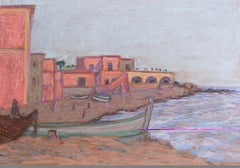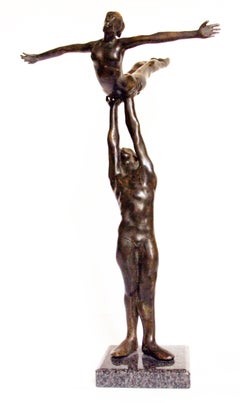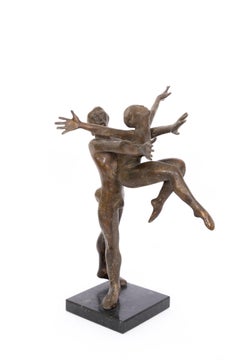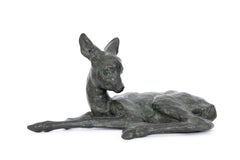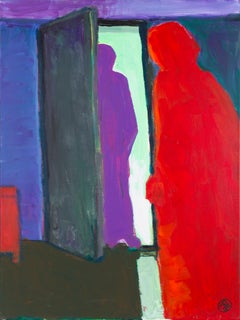Galerie Lehner
to
154
92
54
49
41
23
21
17
13
12
11
9
5
5
5
2
2
1
1
16
11
7
7
6
Ischia II
By Hans Franta
Located in Wien, 9
If you compare Hans Franta’s earliest works – from around 1911 to 1920 – with his later work from the years after the Second World War, the fact becomes obvious that you are dealing ...
Category
20th Century Modern Abstract Paintings
Materials
Pastel
$1,564
Alvin Ailey
By John W. Mills
Located in Wien, 9
John William Mills (born 4 March 1933, London) is an English sculptor.
He studied at Hammersmith School of Art, 1947–54, and at the Royal College of Art, 1956–60. He was a resident ...
Category
1930s Modern Figurative Sculptures
Materials
Granite, Bronze
Bob Fosse
By John W. Mills
Located in Wien, 9
John William Mills (born 4 March 1933, London) is an English sculptor.
He studied at Hammersmith School of Art, 1947–54, and at the Royal College of Art, 1956–60. He was a resident ...
Category
20th Century Modern Figurative Sculptures
Materials
Bronze
$3,024
Frederick Ashton
By John W. Mills
Located in Wien, 9
John William Mills (born 4 March 1933, London) is an English sculptor.
He studied at Hammersmith School of Art, 1947–54, and at the Royal College of Art, 1956–60. He was a resident ...
Category
20th Century Modern Figurative Sculptures
Materials
Bronze
Lying fawn
By Fritz Heidenreich
Located in Wien, 9
Fritz Heidenreich was a German porcelain sculptor and worked primarily with small sculptures and as a ceramist.
Heidenreich worked for the porcelain manufacturer Rosenthal from 1919...
Category
20th Century Realist Sculptures
Materials
Bronze
Message in the Morning
By Robert Hammerstiel
Located in Wien, 9
In his painting, Robert Hammerstiel is in constant search of the balance and harmony of form. In his drastic reduction to the physical essentials and the colourful placarding, he cre...
Category
21st Century and Contemporary Contemporary Abstract Paintings
Materials
Canvas, Acrylic
The yellow separation
By Robert Hammerstiel
Located in Wien, 9
In his painting, Robert Hammerstiel is in constant search of the balance and harmony of form. In his drastic reduction to the physical essentials and the colourful placarding, he cre...
Category
Early 2000s Contemporary Figurative Paintings
Materials
Canvas, Oil
Wooden Heads
Located in Wien, 9
Since Franz Ecker’s early death in 1999 his work has been newly appreciated, what is manifested in numerous exhibitions, catalogues and in the acclaimed film about the artist. He was extremely productive and left behind an almost unmanageable scope of works in various styles. Among them some of the top works that are unparalleled in recent Austrian art history and whose significance has not yet been adequately appreciated.
After finishing his studies in 1966 in class of prof. Sergius Pauser and after receiving his two prizes, Franz Ecker moved back to Leonding where he developed his clear, abstract language of forms. Among his sources of inspiration are Cezanne and Picasso, as well as Martin Polasek who was one of his teachers. This led him to painting in a flat and abstract manner, which triggers a spatial experience through its exact color coordination and strict composition. The strongest period in his oeuvre is the time when his paintings are between figuration and abstraction. Only until around 1975 he additionally creates numerous watercolors, even though he restricts this medium to his more lyrical works.
If Franz Ecker cannot be included in the avant-garde cannon of the 70’s, it is only because he witheld from presenting his works on the art market. Instead of using the opportunities that were offered to him in Vienna, he returned after his time at the academy to Linz where there was no appreciation nor market for his works. Distanced from the established art business, Ecker lives uncompromisingly the precarious life of a lonely genius. An artist myth, which in his case certainly is a bitter reality. Unimpressed by this, Ecker develops an increasingly broad language of forms within the clear line of abstract pictorial conception, which he emphasizes with constantly new forms of signature.
At the end of the seventies his works became more gestural and expressive. His works like “Kafka” anticipate the “Neue Wilden”. When these are celebrated as the “return of painting...
Category
Late 20th Century Abstract Abstract Paintings
Materials
Paint, Oil, Panel, Wood Panel
$4,693
